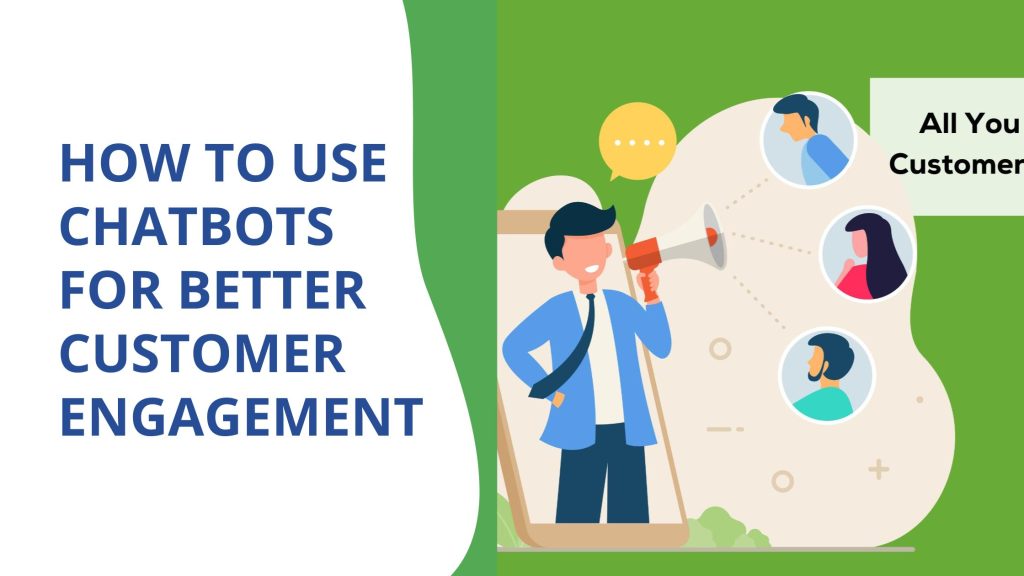In a world where customer engagement is key to business success, chatbots have emerged as powerful tools for connecting with your audience in a more efficient and personal way. In this blog post, we will explore the ins and outs of using chatbots to enhance your customer engagement strategies and drive better results for your brand. Say goodbye to generic interactions and hello to meaningful conversations – let’s dive into the exciting world of chatbot technology!
Introduction: Discussing the rise of chatbots in customer engagement and the benefits they offer.
Are you looking to revolutionize your customer engagement strategy and take it to the next level? Look no further than chatbots! In today’s digital age, chatbots are becoming increasingly popular for businesses seeking efficient ways to interact with their customers. Let’s delve into how utilizing chatbots can enhance your customer engagement game and set you apart from the competition.
First and foremost, chatbots provide an immediate response to customer inquiries. With traditional customer service methods, customers often have to wait on hold or for a representative to get back to them with an answer. This can lead to frustration and dissatisfaction, resulting in a negative customer experience. However, chatbots are available 24/7 and can respond to multiple inquiries simultaneously, providing timely and efficient customer support.
Moreover, chatbots offer a personalized experience for each customer. By utilizing artificial intelligence (AI), chatbots can analyze past interactions and gather information about the customer’s preferences and needs. This allows for tailored responses and suggestions, making the customer feel valued and understood.
Understanding Chatbots: Explaining what chatbots are and how they work.
Chatbots are like digital assistants that can interact with users via text or voice. They use artificial intelligence to understand queries and provide relevant responses in real-time. These bots can simulate conversations with humans, offering a seamless way for customers to get information or assistance without human intervention.
The workings of chatbots involve natural language processing (NLP) algorithms that enable them to comprehend user input and generate appropriate answers. They learn from interactions to improve their performance over time, becoming more adept at understanding and responding accurately to user inquiries.
Through pre-programmed responses and machine learning capabilities, chatbots can handle various tasks such as answering FAQs, guiding users through processes, scheduling appointments, or even making recommendations based on user preferences. Their versatility makes them valuable tools for enhancing customer engagement across different industries.

Benefits of Chatbots for Customer Engagement
Chatbots, also known as virtual assistants or conversational agents, have become increasingly popular in recent years for their ability to streamline and improve customer engagement. With advanced artificial intelligence and natural language processing capabilities, chatbots are able to interact with customers in a human-like manner, providing immediate assistance and support. In this section, we will explore the various benefits of using chatbots for customer engagement.
1. 24/7 Availability: One of the most significant advantages of chatbots is their round-the-clock availability. Unlike human customer service representatives who have limited working hours, chatbots can provide assistance at any time of day or night. This is particularly useful for businesses that cater to a global audience across different time zones. Customers no longer have to wait until business hours to get their queries resolved; they can simply interact with a chatbot and receive instant responses.
2. Instant Responses: With the rise of social media and messaging platforms as preferred communication channels for customers, expectations for real-time responses have increased significantly. Chatbots excel in providing instant responses as they are not bound by human limitations such as fatigue or short attention spans. They can handle multiple conversations simultaneously, ensuring that each customer receives prompt attention and support.
3. Personalization: In today’s fast-paced world, customers expect personalized experiences from businesses they engage with. Chatbots can deliver just that by utilizing data from previous interactions and using it to tailor responses according to each customer’s preferences and needs. This not only creates a more personalized experience but also helps build stronger relationships with customers.
4. Cost-Effective: Incorporating chatbots into your customer engagement strategy can lead to significant cost savings for your business in the long run. As chatbots handle routine inquiries and tasks efficiently without requiring breaks or vacations, businesses can reduce their workforce costs associated with hiring full-time employees solely dedicated to managing customer queries.
5.Collecting Customer Data: Chatbot interactions generate valuable data that can provide insights into customer behavior, preferences, and pain points. This data can be analyzed to identify areas for improvement in customer engagement and inform future business decisions. With chatbots, businesses have access to a wealth of real-time information that can help them better understand their customers and cater to their needs effectively.
The benefits of using chatbots for customer engagement are numerous. From 24/7 availability and instant responses to personalization and cost savings, chatbots offer a wide range of advantages that can enhance the overall customer experience. By leveraging this technology, businesses can not only improve customer satisfaction but also gain valuable insights for long-term success.
Implementing Chatbots in Your Business: A step-by-step guide on how to integrate chatbots into your website or social media platforms.
By following the step-by-step guide provided on how to integrate chatbots into your website or social media platforms, you can harness the power of this technology to enhance customer engagement. Embracing chatbots allows businesses to offer immediate responses, personalized interactions, and 24/7 availability to their customers. This not only improves customer satisfaction but also boosts efficiency and productivity within your business operations. So, why wait? Start implementing chatbots today and take your customer engagement strategies to new heights!
Step 1: Determine the purpose of your chatbot
Before implementing a chatbot, it’s important to determine its purpose and how it will benefit your business. Some common use cases for chatbots include customer service, lead generation, and sales support. Identify the specific areas in your business where a chatbot can add value and improve efficiency.
Step 2: Choose a chatbot platform
There are several platforms available for creating and implementing chatbots. Some popular options include Chatfuel, ManyChat, and Botsify. Research each platform to find the best fit for your business needs.
Step 3: Design your chatbot conversation flow
The key to an effective chatbot is designing a conversation flow that feels natural and human-like. Start by mapping out all possible user inquiries and responses. Then, create a branching logic that guides the conversation based on the user’s input.
Step 4: Integrate with your website or social media channels
Once you have designed your chatbot conversation flow, it’s time to integrate it into your website or social media channels. Most chatbot platforms offer simple integration options with popular platforms like Facebook Messenger or WordPress websites.
Step 5: Test your chatbot
Before launching your chatbot live, it’s essential to test it thoroughly. Try out different scenarios and make sure the conversation flow is smooth and error-free. Ask colleagues or friends to test it as well and provide feedback.
Step 6: Train your chatbot
Chatbots use artificial intelligence (AI) and natural language processing (NLP) to understand user inquiries. It’s crucial to train your chatbot by providing it with a wide range of possible questions and responses to improve its accuracy over time.
Step 7: Monitor and update your chatbot
Even after launching your chatbot, it’s important to monitor its performance and make updates as needed. Analyze user interactions, identify areas for improvement, and continually train your chatbot for better results.
Step 8: Promote your chatbot
Let your customers know about your new chatbot! Promote it on your website, social media channels, and other marketing materials. Encourage users to try it out and provide feedback.
Step 9: Continuously improve
As technology evolves, so do customer expectations. Keep an eye on new features and updates in the chatbot space, and continuously work on improving your chatbot’s capabilities.
Congratulations! You have successfully integrated a chatbot into your business operations.
Conclusion
As businesses strive to constantly improve their customer engagement, chatbots have emerged as a valuable tool. By implementing these 7 tips for using chatbots effectively, companies can provide personalized and efficient support to their customers while also streamlining their own operations. Chatbots offer endless opportunities for automation and enhanced communication, making them an asset for any business looking to enhance customer satisfaction and drive growth. So why not give it a try and see the positive impact that chatbots can have on your customer engagement?

